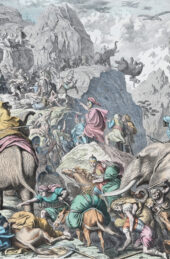The Roman army waged war in the most brutal of fashions. Its aim was the total subjugation of its enemies. Well, so far, so obvious. What is perhaps less understood is the way it valued fear itself as a weapon. Ably illustrated by the tactical use of projectile weapons in a siege.
When we imagine a Roman siege, Caesar’s great circumvallation of Alesia and the defeat of Vercingetorix may come to mind. Or the massive ramp built against the cliff ramparts of the fortress of Masada during the Great Jewish Revolt. But, it is Rome’s various campaigns against Britain’s Iron Age tribes, and their ‘oppida’, where it used all of the individual pieces of its war-machine to terrifying effect.
The legions used four types projectile weapon:

Ballista. Credit: Creative Commons
The II Libre ballista. This catapult fired fist-sized stone balls. It was an anti-personnel weapon, not designed to shatter walls, only bodies. The ammunition acted like a cannonball, maiming whomever was unfortunate enough to get in its way. But it rarely stopped where it first struck. In the right conditions, the ball would bounce continuing its destruction, shattering legs and bodies on its deadly journey.
The scorpion. A light bolt-throwing weapon. There may have been one or two aligned to each century and extremely accurate in trained hands. At Hod Hill in Dorset, several bolts were discovered inside the excavated remains of a roundhouse on its summit. It is believed that Vespasian’s II Augusta legion targeted the local chieftains family. Likely bringing the battle to a swift end.
Massed bowmen. Throughout much of Rome’s time in Britannia there were regiments of Syrian or Arabic archers stationed in the province. Specialists in their trade. Known for using a trilobate arrowhead that could penetrate deeply into the unarmoured bodies of an Iron Age warrior. They caused immense damage to those wounded, when an attempt was made to extract them.
Sling bullets. Deadly when utilised in coordinated volleys. Lemon shaped and often cast of lead, field tests have shown they had a similar kinetic energy as a modern handgun. Examples have been found at the auxiliary forts of Birrens and Vindolanda. But there was another even more sinister type. A smaller category, recently discovered, could be ‘fired’ 3 or 4 at a time. An early form of grapeshot. Additionally, each had a 5mm hole drilled into its side. Under test conditions, not only did they become invisible to the eye inflight, but also buzzed like angry wasps. When slung in a fuselade it must have sounded like a swarm. This early form of psychological warfare, would have had a similar terrifying effect to that inspired by the screaming of diving Ju-87 Stukas during the Blitzkrieg in early World War II.

Bar Kokhba, by Arthur Szyk
Individually the weapons would have been frightening enough. But used together, would have created a cataclysmic event unknown to that civilisation. This is exemplified by what was revealed in a series of archaeological investigations at Burnswark hill fort in Dumfriesshire. Hundreds of lead sling balls have been uncovered, across the site, of the nature described above. Several tribolate arrowheads and scorpion bolts were also found. The arsenal is completed by the finds of a number of ballista balls. This isolated hill is held in the vice-like grip of two massive forts. One, to the north, is unusually elongated, positioned to prevent any attempt to flee. In the south is the main assault fort. To its fore are three huge mounds, believed to be ballista platforms.
It is hard not to pity the warriors of the local tribe, who had gathered on its summit. Exposed and forced to take cover, faces pressed into the earth as they were assailed by a barrage of thousands of missiles, their screams accompanied by the sound of angry wasps.
Finally, when the commander, possibly the veteran Quintus Lollius Urbicus fresh from the Bar Kokhba Revolt in Judea, was satisfied. He would have sent in his legions, through the three 10-man wide gates, in testudo formation. In the battle’s aftermath, it is hard to imagine there were any survivors left for the slave markets.
Alistair Tosh is the author of Siege, published by Sharpe Books.







